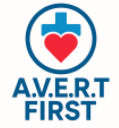Executive summary
AVERT Harm™ (full framework) and AVERT First™ (frontline first-aid style response) together provide a replicable, evidence-informed curriculum and service model for reducing harm across nine domains and three training tracks (Community / Peer, Healthcare & Human Services, Public Health & Systems Leadership). These programs are designed to integrate with established public-health, health-care, and community networks worldwide and to be delivered flexibly (in-person, hybrid, and online), translated for major global languages, and adapted to local systems and vulnerable populations. (avertharm.com)
Core definitions (short)
- AVERT Harm™: The comprehensive, multi-track educational framework for identifying, assessing, and intervening across the full spectrum of harm — from early indicators to post-harm recovery and system adaptation. It contains the 10-step ENGAGEMENT algorithm, typology lenses, and modular tools for each track. (avertharm.com)
- AVERT First™: The rapid, front-line “first aid” protocol and entry course (simple, teachable actions) designed to stabilize situations, reduce immediate risk, and link people to AVERT Harm pathways. It functions as the accessible gateway for communities, workplaces, and non-clinical responders. (avertfirst.com)
The three tracks (how they map and operate)
Each track uses shared tools and language but is role-tailored for appropriate scope and escalation.
- Community / Peer Track (Guardian)
- Audience: peers, community leaders, volunteers, educators, shelters, outreach workers.
- Focus: early recognition, de-escalation, immediate safety, referral and solidarity action.
- Role: act as embedded first responders who stabilize, preserve dignity, and bridge to care.
- Healthcare & Human Services Track (Vanguard / Care Operators)
- Audience: CNAs, nurses, behavioral health staff, social workers, case managers, primary care teams.
- Focus: clinical assessment, coordinated short-term management, care planning, targeted referrals.
- Role: apply structured scans and evidence-based interventions; coordinate across social and medical systems.
- Public Health & Systems Leadership Track (Elite / Strategist)
- Audience: public health officials, system designers, policy makers, program leads.
- Focus: surveillance, population risk mapping, policy and resource alignment, syndemic mitigation.
- Role: design and fund system-level prevention, ensure cross-sector coordination and scale.
All tracks use the same 9 domains (below) to ensure interoperability and consistent assessment language.
The nine domains of harm (unified lens)
AVERT treats harm as multi-domain and interdependent. The curriculum ensures each module includes domain-specific competencies and cross-domain linkages:
- Mental & Behavioral Health (suicide risk, depression, SUD)
- Chronic Physical Illness (diabetes, dialysis, cardiovascular disease)
- Reproductive & Maternal Health (maternal mortality, postpartum complications)
- Youth & Developmental Risks (bullying, exploitation, digital harms)
- Elder Health & Frailty (falls, dementia, elder abuse)
- Provider & Systemic Harm (clinical error, inequity, poor communication)
- Social Determinants & Structural Risk (housing instability, poverty, legal status)
- Cumulative & Syndemic Harms (overlapping epidemics: HIV, SUD, violence)
- Digital & Algorithmic Harms (misinformation, surveillance impacts)
Each module emphasizes: how domain A affects domain B (e.g., how housing instability increases chronic disease risk and undermines mental health), translated into actionable assessment and intervention guidance.
Curriculum structure — how the pieces fit
- Pre-Engagement Module (Communication & Pre-Engagement Considerations)
- Role clarity, cultural humility, safety and boundary setting, scene assessment, psychological safety.
- AVERT First (Entry module)
- Short, 3–5 action steps (A.I.D. or A.C.T. style), pocket cards, workplace/lay versions, and community rollouts.
- AVERT Harm Core (10-step ENGAGEMENT)
- Full 10-step algorithm with associated tools (S.C.A.N., H.A.R.M. Typology, A.B.C.D.E., R.E.A.D.Y., CHECK-IN). Practical scenarios for every track.
- Domain Modules (9 domains)
- Each contains screening tools, role-specific checklists, quick escalation rules, and culturally adapted case studies (e.g., maternal hemorrhage + postpartum psychosis; dialysis interruption + infection risk; burn trauma + homelessness).
- Systems & Leadership (Public Health Track)
- Surveillance design, policy levers, community engagement strategy, resource mapping, and ethical governance.
- Integration & Handoffs
- Standardized handoff protocols (G.P.S., C.O.M.P.A.S.S.), data sharing agreements, community-clinic-public health SOPs.
- Recovery & Adaptation
- Debrief, restorative practices, organizational learning, resilience building.
Evidence base & practice principles (why this works)
- Integration of behavioral and physical health improves outcomes and patient experience; collaborative care models reduce symptom burden when adapted to context. (PubMed)
- Meaningful community engagement improves access, trust, and adoption—foundational for durable prevention strategies. (ATSDR)
- Psychosocial interventions that address co-occurring disorders (mental health + substance use) are supported by systematic reviews and reduce harm when delivered in coordinated models. (Cochrane)
(AVERT’s curriculum packages these evidence-based principles into practical, role-specific tools and workflows so teams can implement — not just learn — integrated responses.) (avertharm.com)
Global implementation blueprint & regional priorities
Delivery model: modular, tiered training (AvertFirst → Core Harm modules → Domain deep dives → Leadership lab). Offerings: e-learning, short in-person workshops, train-the-trainer, immersive simulations.
Languages & accessibility: curriculum designed for translation into major languages and adaptation to local health literacies and technologies. (Suggested baseline rollout in 11 languages for global accessibility; local partners should co-produce translations and glossaries.) (avertfirst.com)
Regional focal points:
- Latin America & Caribbean: maternal health, youth violence, substance harms, informal settlements—emphasize community bridges and mobile outreach.
- North America: opioid crisis, homelessness, chronic disease comanagement, digital harms—integrate with primary care collaborative models.
- Sub-Saharan Africa: syndemics (HIV, TB, SUD), maternal mortality, health workforce gaps—focus on community health workers + system surveillance.
- Asia-Pacific: disaster-related trauma, migrant worker health, chronic illness management—design for surge capacity and digital integration.
- Europe: aging populations, migration, mental health—emphasize elder care modules and system-level policy alignment.
- MENA / Conflict Zones: displacement, trauma, maternal care gaps—prioritize low-bandwidth training, trauma-informed community interventions.
Populations of special focus: people experiencing homelessness, people with chronic dialysis needs, burn and trauma survivors, pregnant and postpartum people, older adults with frailty, and underserved youth. For each, AVERT provides tailored module checklists, referral trees, and harm-reduction guidance.
Certification, badges & credentialing
- AvertFirst Certification — Basic and Advanced-level first-aid for harm (lay + workplace).
- AvertHarm Certification-Basic and Advanced-level Impact Reduction Response
- Guardian Badge — community track competency.
- Vanguard Plus Badge (or alternative badge name you choose) — healthcare & human services competency.
- Elite Badge — public health & systems leadership competency.
Stackable micro-credentials for domain specialties (e.g., Maternal Harm Prevention, Dialysis Continuity, Burn & Trauma Stabilization).
Monitoring, evaluation & quality improvement
- Core indicators: detection rates (early signs), time-to-escalation, successful handoffs, re-presentation/readmission rates, client-reported safety/trust.
- Implementation research: pragmatic trials and pre/post evaluations to adapt tools and measure impact in different contexts (align with local IRBs and ministries).
- Data governance: prioritize privacy, consent, and minimal necessary data sharing; standardize handoff fields using G.P.S. and C.O.M.P.A.S.S. templates.
Partnerships & system integration (how to scale)
- Health systems: embed modules into primary care, ED, and behavioral health training (use collaborative care evidence). (PubMed)
- Public health agencies: incorporate AVERT surveillance lenses and domain indicators into existing syndromic systems.
- Community organizations: co-deliver training and co-create translations; apply CDC/community engagement principles for fidelity and trust. (ATSDR)
- Academia & evaluation partners: measure outcomes and publish implementation science papers to refine the model.
- Donors & philanthropies: support pilots in high-need regions and workforce development.
Practical next steps (90-day pilot roadmap)
- Select pilot site (one community + one health system + one public health partner).
- Deliver AvertFirst to 200+ frontline staff/peers and core AVERT Harm core to 50 practitioners.
- Implement handoff protocol (G.P.S. + C.O.M.P.A.S.S.) and measure time-to-handoff and follow-up rates.
- Collect baseline & 3-month outcomes (detection, escalation, linkage to services, user satisfaction).
- Iterate and scale with local trainers and language adaptations.
Why this is different and necessary
AVERT packages practical, teachable, role-relevant tools with a systems view: it is intentionally designed to treat harm as interconnected (not siloed), to translate evidence into usable practice across three tracks, and to operationalize prevention, response, and recovery across the nine domains. It’s a movement toward integrated, context-aware harm reduction that can be localized and scaled. (avertharm.com)
Key references & evidence (selected)
- AVERT Harm / AVERT First program materials and model overview. (avertharm.com)
- Integrating behavioral health and primary care: improved outcomes and patient experience. (PubMed)
- Principles of Community Engagement (CDC/ATSDR). (ATSDR)
- Psychosocial interventions for co-occurring severe mental illness and substance misuse (Cochrane review). (Cochrane)
Contact & Next Steps
To inquire about training, development, or implementation of the A.V.E.R.T. Harm™ and A.V.E.R.T. First™ frameworks across public health, healthcare, human services, and community frontline settings, you can contact them directly below.
If you are seeking to implement A.V.E.R.T. Harm™ or A.V.E.R.T. First™ training in your organization—whether in public health, healthcare, human services, or frontline community settings—contact us today, to begin your journey toward safer, more responsive systems.
Care Republic Inc.
212-687-2273 or 212-OUR-C-A-R-E
Email:admin@carerepublic.org
RE: Integrated Community & Healthcare Training Programs
Correspondence: AVERT Harm Training Programs
P.O. Box #123
Babylon, NY 11702




